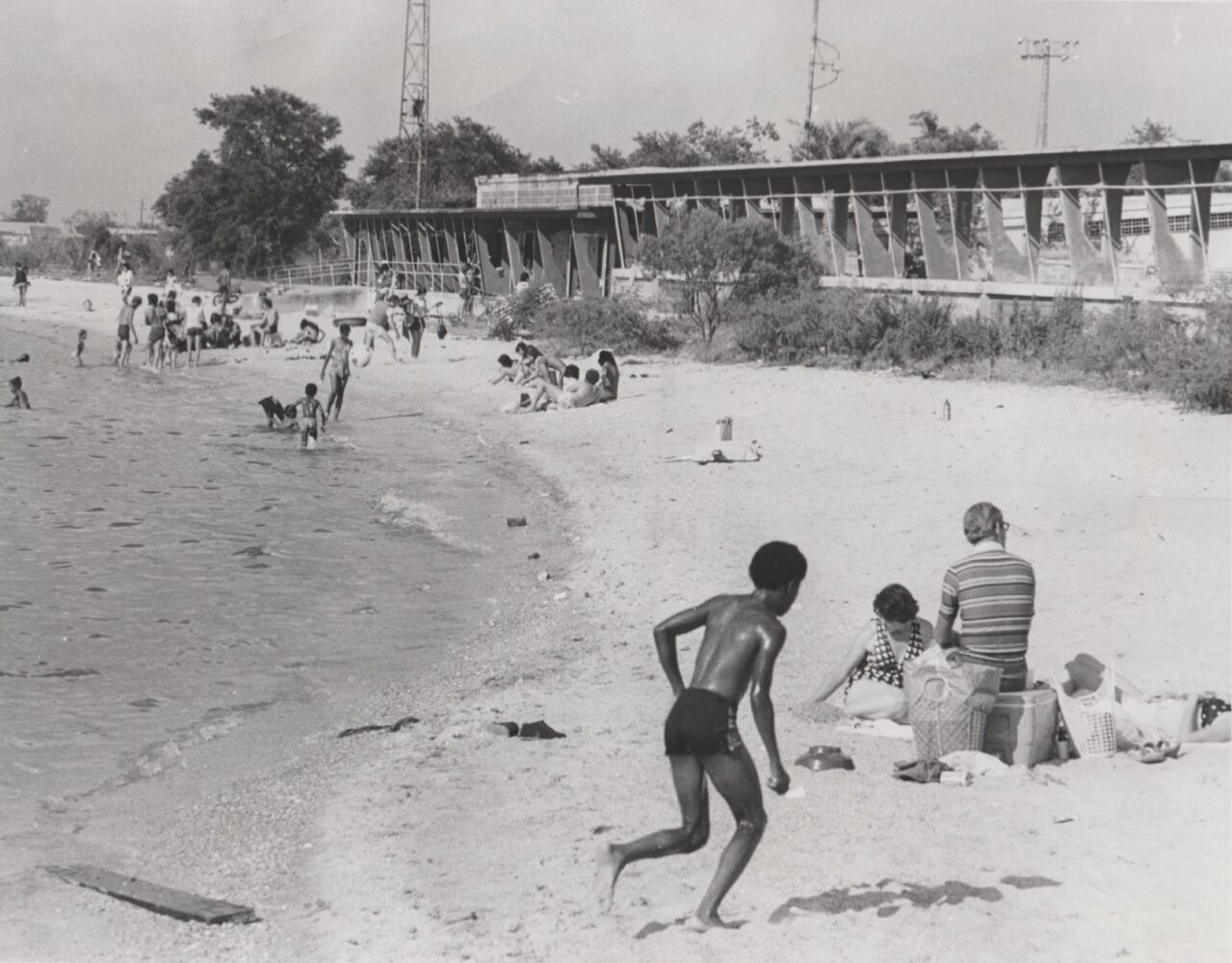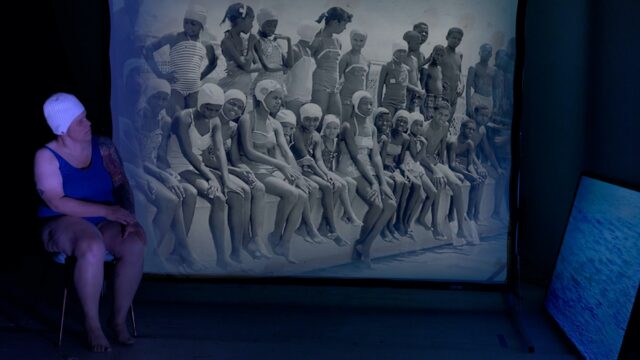They Gave Us a Beach
The memory of a Black beach on Lake Pontchartrain
Published: August 31, 2021
Last Updated: March 22, 2023

Image by Lionel M. Cottier, New Orleans States-Item, collection of Danielle Abrams
Even after the site was closed, local people, mostly Black, gathered for fun, as seen in this image from the New Orleans States-Item, July 5, 1977.
When my Black aunt planned a trip to Jones Beach in New York for my cousins and I, the rollout was much different. Unlike my mother, my aunt did not have a car, so we took the city bus. At seven in the morning, we waited at the bus stop with coolers and thermoses filled with fried chicken, deviled eggs, celery stuffed with pimento cheese, and pink lemonade. There was enough food for my cousins and me to have multiple lunches. My aunt always carried a big umbrella to shade all of us kids. No matter how dark or light we were, nobody would be laying out in that hot sun. She rubbed us down with Coppertone, and we had white smears of lotion on our noses and cheeks. When I went to the beach with my aunt and my cousins, everybody knew I was Black.
One time when we were all riding back from the beach, my cousin started looking scared, and we were all asking her what was wrong. She wouldn’t answer, but finally my aunt got it out of her: she had to go to the bathroom. The trip was at least forty-five minutes back to the city, and we didn’t know how she was going to hold it in. I thought to myself that if we were in my mother’s car, we could stop at the 7-Eleven so my cousin could go. We didn’t have that choice, though, sitting on this bus, and I could tell my cousin feared leaving behind a wet seat. She was beginning to cry now, and I wished that some of her pee might work its way through her wet tears. My cousin wouldn’t have been sitting on that bus having to hold in her urine if she wasn’t Black.
Harry Batt, grandfather of actor Bryan Batt, founded New Orleans’s Pontchartrain Beach, a lakeside amusement park that was segregated from 1928 to 1964. An innovation in engineering called the screw pump, worked by an incarcerated chain gang, drained part of the Lake Pontchartrain waterfront, and fifty acres of pristine lakefront were devoted to Pontchartrain Beach. The New Deal enabled whites to invest in modern housing along the lakefront area. Black people were kept far away from Pontchartrain Beach and the renovated lakefront.In 2018, just in time for New Orleans’s three-hundredth anniversary, Bryan Batt wrote Pontchartrain Beach: A Family Affair to commemorate his family’s “amusement park accomplishments,” paying tribute to all the white families that patronized his family’s beach. Batt fails to mention in his book that Black people were not allowed at Pontchartrain Beach. Their option during the hot summertime was to swim in eroded and hazardous sections of the lake that were ruined by the screw pump upgrades. When attempting to swim, if they survived, they often confronted either white violence or police harassment. Finally, after twenty-six years of pressure from the NAACP and the New Orleans Urban League, the city did open a beach for African Americans. Lincoln Beach was a short-term solution, a swimming paradise that disguised the indignities of segregation. It silenced the outrage of family, friends, lovers, and spouses that had grieved multiple drownings in that lake.
As soon as the Civil Rights Act passed, the white management of Lincoln Beach promptly shut their rides, abandoned their posts, and the city cut the beach’s funding. It was 1964, and Black people could patronize the superior and formerly “whites only” Pontchartrain Beach, which remained in operation for another twenty years. Harry Batt covered the entire grounds with fencing to keep out what he called “thugs,” changed his ticket policy to one-ticket-per-ride, and added on a gate fee. He hired a few Black people, but at lesser wages than whites in the same jobs. Once Black visitors joined the crowds at Pontchartrain Beach, it didn’t take long for whites to recede. They returned to their beach clubs and private pools, and Pontchartrain Beach, once whites only, now looked like Lincoln Beach, all Black.
Lincoln Beach’s ecology today is an amalgamation of indigenous grasses, birds, wildflowers, and amphibious creatures, along with the dust and steel patina from fifteen acres of rides, three swimming pools, a restaurant with patio, and mid-century concrete- and ceramic-tiled architecture. I can hear ghostly echoes from the most influential Black American musicians while walking the still-intact concrete midway. Lincoln Beach is a preserve for overlooked species, both natural and human. Unhoused residents live in tents under the three remaining canopies, and there are DIY hammocks tied to trees. Graffiti artists transmogrify arched concrete pillars, which accrue layers of images—Daffy Duck becomes Bart Simpson, covered by a tribute to Fats Domino. Over the past five years, I have witnessed the transitions of sprayed hue and texture upon four buttresses that are the remaining supports of what was once the canopy for an Olympic-sized swimming pool. Lincoln Beach’s graffiti is a new clock, specific to the itinerance and ephemerality of this site.
When I learned about Lincoln Beach in New Orleans, I thought of my aunt taking us all out to Jones Beach by bus. I thought about her picnic lunches and her beach umbrellas which covered the lot of us. What would it have been like at Lincoln Beach with her in 1954, if that had been the only place we could go as a colored family? What would she have said to my cousins and me when we asked about riding the big rollercoaster at the better amusement park down the road—Pontchartrain Beach—the white one? She’d either cuss them crackers out or tell us that the seats on their rides were nasty and dirty.Then again, if I was in New Orleans with my mother in 1954, we’d have gone to Pontchartrain Beach, with the big roller coaster and the nasty seats, and nobody would give me a second look. All the white kids would be eating cotton candy and getting Elvis Presley’s autograph, and I’d have a mask on. That mask talked right back into my face ceaselessly about who I really was, and it disconnected me from my white mother. But we would pretend we were the same, she and I, as we walked along the boardwalk, admiring the prizes all the white children had won.
I’m taking my aunt to Lincoln Beach today. I want us to see where Black people once played, swam, danced, listened to music, and didn’t have to deal with white people. I’ll pack our lunch this time—oyster po boys—although the liquory shellfish might be too ambiguous for my aunt’s tastebuds. We’ll sit under the shady concrete overhang and look out at the lake. The rides will be vanished, but we’ll see the bricks that were once the foundation of that Olympic-sized swimming pool. My aunt had never learned to swim, so she’ll be glad that pool had disappeared, but we’ll listen as the lake pushes its way under the brick caverns and bellows hollow sounds, like a groaning organ.My aunt will say to me, “You know, you wouldn’t’ve had to be here at Lincoln Beach—you could have passed and gone ahead to Pontchartrain Beach.”
My aunt is light like me, without even a curl in her hair, so I’ll ask her, “Would you have done that?”
She’ll shake her head. “No, baby, I’m a Black woman with four Black children.”
My aunt’s children are mixed like me, but her husband’s drinking put her in charge of the child-rearing, and she raised her daughters to be Black. Some of my cousins are even lighter than me, but they know what they are.
My aunt is an ancestor. She has the perceptions of one who has passed on and sees a little something else. She’ll know there were sacrifices that went into building this Black New Orleans beach. She’ll suspect that the beach was never built to “better the race relations,” as they said. She’ll say, “Something happened.”
I’ll tell her, “You’re right. Six lives were lost, all at once. They drowned in sinkholes on the lakebed because, until Lincoln Beach, Blacks had nowhere else to swim. Two of them were sisters, found later with their hands clutched together.”
My aunt will open her eyes wide and say what she’s always said to me. “They hate us. They really hate us.” She’ll mean white folks.
My aunt and I will sit awhile at Lincoln Beach, in the aftershock of segregation. I’ll look around, and see the shreds of a Negro beach that were left behind for Negros. I’ll understand this hate she’s always talking about.

Abrams incorporates historical images of Lincoln Beach into her performance art exploring the histories of segregated spaces.
THIS IS
Lincoln Beach
Historical Black Heritage Site
New Orleans for New Orleans Coalition
They’ve disposed of fifteen tons of trash and cleared minimal woodland that created obstacles on beach paths, but Pellet and his clean-up crew are considered trespassers on Lincoln Beach. There is a cruel irony in prohibiting a Black man, in 2021, from entering a historical and now gated site that was designed in the Jim Crow era to segregate Blacks. Pellett and crew have been cited by NOPD with tickets when they park their cars near the beach, along a deserted stretch of Hayne Boulevard. Pellet perseveres, and his protective gaze is evidenced in photos and movies that are taken on his cell phone from a kayak. He reassures his 4,338 Facebook followers that they shouldn’t avoid Lincoln Beach because of the alligators that populate the often flooded entryway: “Those gators are more scared of you than you are of them!” He narrates his movies in his signature Afro-Caribbean diasporic / Third Ward patois, with his Cheshire Cat grin present in every image. Snippets of television news highlight his prior presence at the beach, wearing a dashiki and swinging a scythe against bamboo stalks.
When I spoke with the elders who made their way to Lincoln Beach in the 1950s, they all expressed a similar sentiment: “I felt safe there.” Mr. Leon Waters, a New Orleans historian, activist, griot, and also a former Lincoln Beach patron, summarized the feral acreage that Lincoln Beach is today. He turned to me and said, “They let that forest grow so we’d forget it ever happened.”
Danielle Abrams is a performance artist, who was in residency at Bureau of Change and a visiting scholar at the Midlo Center for New Orleans Studies at the University of New Orleans. Lincoln Gave Us a Beach is a live-streamed performance created in collaboration with video artist Mary Ellen Strom. Abrams and Strom are developing site-specific performances that examine segregated recreational sites in northern and southern cities. Abrams is a professor of practice at School of the Museum of Fine Arts at Tufts University in Boston.

